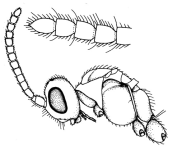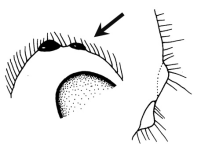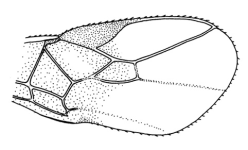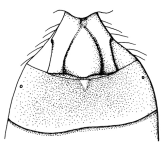Scientific name
Bracon (Habrobracon) hebetor Say (=Bracon hebetor Say)
Taxonomic position
Hymenoptera: Braconidae: Braconinae
Diagnosis
Length of fore wing 1.7-2.6 mm, of body 1.3-2.7 mm. Colour very variable and similar to that of B. brevicornis: pterostigma rather dark brown, with sometimes a large pale basal spot; body nearly completey yellowish brown to largely dark brown or black. Antenna of female with 13-14
segments, submoniliform (Fig.), shorter than length of head and mesosoma combined or of equal length (Fig.); antennal of male with 20-23 segments (Fig.); setae of vertex erect, partly reaching above upper level of posterior ocellus (Fig.); clypeus nearly flat to convex (Fig.); clypeus, face and frons finely
granulate; face with some long setae (Figs.); vertex mainly smooth. Mesoscutum largely setose, shiny, smooth; scutellar sulcus narrow and distinctly crenulate. Vein 3-SR of fore wing 0.9-1.2 times vein r, rarely up to 1.4 times (Fig.); veins l-SR and 3-SR short (Fig.); marginal cell of fore wing medium-sized,
ending distinctly removed from apex of wing (Fig.); tarsal claws with small acute lobe (Fig. 199). Propodeum superficially granulate or smooth; length of first tergite about 0.8 times its apical width, its surface smooth; dorsolateral carinae of first tergite absent (Fig.); second tergite without mediobasal area; second metasomal suture shallow to rather deep, nearly straight and usually
smooth (Fig.); second to seventh segments superficially granulate to (mainly) smooth, shiny; length of ovipositor sheath 0.21-0.30 times fore wing and about twice length of first tergite.
Can be identified by the following characters: Antenna of female with 13-14 segments, shorter than length of head and mesosoma combined or of equal length; antennal segments of male 20-23. Setae of vertex erect, reaching above upper level of posterior ocellus; vein 3-SR of fore wing 0.9-1.2 times vein r, rarely
up to 1.4 times.
 Fig. 1 Fig. 1
 Fig. 2 Fig. 2
 Fig. 3 Fig. 3
 Fig. 4 Fig. 4
Distribution
Cosmopolitan.
Hosts
An extremely polyphagous ectoparasitoid, like B. brevicornis; attacking Crambidae and
pyralidae in stored products, and in the field other lepidopterous families such as Noctuidae, Tortricidae, and Gelechiidae may also be attacked.
It is a major parasitoid of the rice moth, Corcyra cephalonica (Stainton), the most widely used factitious host in Indian commercial insectaries and considered as a threat to corcyra production.
References
- Singh, S.P. 1995. Technology for production of natural enemies. Technical Bulletin No. 4, Project Directorate of Biological Control, Bangalore-24. 221 p.
- van Achterberg, C. & Walker, A.K. 1998. 17. Braconidae, pp. 137-185. In: African cereal stem borers: Economic importance, taxonomy, natural enemies and control (Ed. A. Polaszek). CAB International / CTA. 530 p.
Image credit
The line drawings are redrawn from van Achterberg and Walker (1998).
|